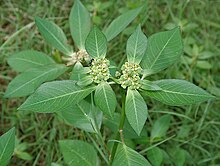Chhiûⁿ-bî-lūi
Chhiûⁿ-bî-lūi (eng. rosids) sī khui-hoe si̍t-bu̍t ē-té chi̍t-ê clade (tan-hē-thóng kûn), hâm 70,000 chéng,[2] tī khui-hoe lūi lāi-bīn chiàm chhiau-kòe sì-hun-it.[3]
| Chhiûⁿ-bî-lūi Sî-kan hoān-ûi: Creta-kí - hiān-chāi | |
|---|---|

| |
| Euphorbia heterophylla | |
| Kho-ha̍k hun-lūi | |
| Kài: | Plantae |
| Clade: | Angiosperms |
| Clade: | Eudicots |
| Clade: | Superrosids |
| Clade: | Rosids |
| Bo̍k[1] | |
Chham-chiàu
siu-kái- ↑ Angiosperm Phylogeny Group (2016). "An update of the Angiosperm Phylogeny Group classification for the orders and families of flowering plants: APG IV". Botanical Journal of the Linnean Society. 181 (1): 1–20. doi:10.1111/boj.12385.
- ↑ Hengchang Wang, Michael J. Moore, Pamela S. Soltis, Charles D. Bell, Samuel F. Brockington, Roolse Alexandre, Charles C. Davis, Maribeth Latvis, Steven R. Manchester, and Douglas E. Soltis (10 Mar 2009), "Rosid radiation and the rapid rise of angiosperm-dominated forests", Proceedings of the National Academy of Sciences, 106 (10): 3853–3858, Bibcode:2009PNAS..106.3853W, doi:10.1073/pnas.0813376106, PMC 2644257 , PMID 19223592
- ↑ Robert W. Scotland & Alexandra H. Wortley (2003), "How many species of seed plants are there?", Taxon, 52 (1): 101–104, doi:10.2307/3647306, JSTOR 3647306
| Pún bûn-chiuⁿ sī chi̍t phiⁿ phí-á-kiáⁿ. Lí thang tàu khok-chhiong lâi pang-chō͘ Wikipedia. |